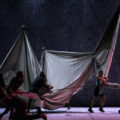Notes on “Relaxed Performances”
In early January I went to the festival Tanztage Berlin 2020 in the Sophiensæle to attend a contemporary dance performance. Before we, the spectators, were allowed to climb the stairs to the so-called wedding hall, a staff member revealed that the following performance would be a Relaxed Performance, allowing people to experience the performance in a laid-back atmosphere, with permission to talk and to move around. Relaxed Performance – actually to me this term was new. So, the following dance performance entitled La Postal de Nuestra Existencia by Areli Moran was to be different from the other performances I had seen so far.¹
During Areli Moran’s performance — which, by the way, was choreographically superbly executed and convincingly strong in terms of content; it was about the love of one’s own body hair, standing up to one’s individual hairstyle against heteronormative norms of beauty and “smooth” eroticism, as a dance-like self-exploration and liberation — the stage space was indeed bright, and knowing that we were allowed to move around and to make noise created a pleasant atmosphere. However, both the faux leather bench I sat on and the polished linoleum flooring squeaked, so I remained rather motionless. At the same time, I was caught in the spell of the performance and hardly managed to communicate with my seat neighbour.
Nonetheless, the format of Relaxed Performances appealed to me, hence on my way home, I browsed the mobile website of the Sophiensæle and found the following explanation under the tab “Accessibility”:
“Selected performances will take place as Relaxed Performance. Relaxed Performances are aimed at all those who feel more comfortable in a relaxed and sensory relaxed atmosphere. The light in the auditorium is on to avoid total darkness. In addition, hearing protection is provided in case it gets too loud. Those who wish can come and go during the show. Silence is not compulsory. Those who need a break can retire to the foyer.”
Arriving at my place, I continued the research using a search engine and was redirected to several English language websites. At first sight, I noticed that Relaxed Performances have been part of the programme of large and small-scale theatres in the UK and the USA for several years now.
The respect for neurodiversity in (“high”) cultural institutions and consequently its active consideration in events and mediation programmes is quite new. At the end of the 1990s in the context of the neurodiversity paradigm, a sensitivity was created, especially in the field of education, for that what is commonly being referred to as neurological “disorders” deviating from the “norm”, such as dyscalculia, ADHD and autism, should no longer be considered “abnormal” but part of human diversity.² Even if globalised societies seem to be reluctant to abandon their norms and pathologies, an anti-discriminatory movement towards more respect for diversity and intersectionality is overdue. Consequently, the choice of the adjective “relaxed” in Relaxed Performances does not refer so much to the content of a performance as to the spatial and atmospheric situation in which a performance takes place.
However, the fact that during the performance I hardly dared to change my position or was too captivated to start a conversation about what I had experienced, could possibly also be explained by a socialisation-related lack of experience, accompanied by low self-confidence in the context of cultural performances.
Through studies in the field of cultural theory and fine arts, as well as through private interest, I have been encouraged to experience a great number of performances, both in large-scale institutions and in smaller theatres and festivals – but I did not grow up with such cultural events. It was not until the beginning of my studies in a large German city on the Rhine River that I was able to experience the variety of cultures that formerly seemed to be unreachable from my rural hometown — which could also be explained by my social background. Over time, I have acquired a certain habitus, knowing roughly how I “should” behave in a ballet at the Berlin State Opera or during a performance in the Sophiensæle, understanding codes and “rules”, and can “afford” a ticket for the theatre once in a while. Nevertheless, I often feel like an “intruder”, caught as a “class refugee”³, out of place.
The speech act that preceded Areli Moran’s dance performance in the Sophiensæle and which announced it as a Relaxed Performance, still gave me a welcoming feeling in the spirit of “You’re OK here” — even though I did not make use of the right to move around or to talk during the performance itself. In any case, the relaxation in my head and on my own hairy legs provided a precious, almost heterotopic experience. Why can’t every performance be so relaxed?
Relaxed Performances are an essential contribution towards increasing the cognitive and social diversity among the spectators of performing arts audiences. Let us collectively consider how we can support, conceptualize, execute and attend diversity-sensitive performances, also facing the current quarantine situation. Therefore it is inevitably fundamental to take into account the social, financial and linguistic aspects in relation to power-critical, anti-discriminatory reflection on accessibility and intersectionality.
¹ Although one performance never resembles the other and the time-space-structure is always unique. Erika Fischer-Lichte aptly describes this in The Transformative Power of Performance: A New Aesthetics (2004/2008).
² cf. National Symposium on Neurodiversity at Syracuse University, 2011.
³cf. Didier Eribon Returning to Reims (2009/2016) and Gesellschaft als Urteil (2013/2017) [translated: Society as Verdict – apparently there’s no English version available yet].






